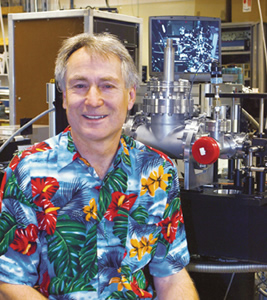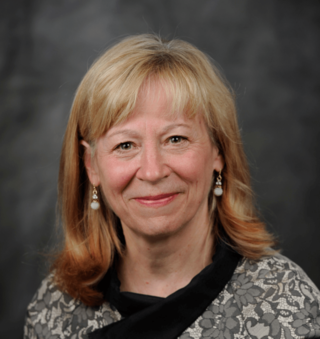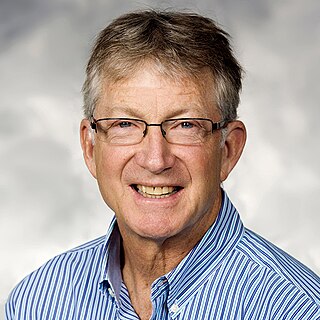
Denis James Evans, is an Australian scientist who is an Emeritus Professor at the Australian National University and Honorary Professor at The University of Queensland. He is widely recognised for his contributions to nonequilibrium thermodynamics and nonequilibrium statistical mechanics and the simulation of nonequilibrium fluids.
Jean M.J. Fréchet is a French-American chemist and professor emeritus at the University of California, Berkeley. He is best known for his work on polymers including polymer-supported chemistry, chemically amplified photoresists, dendrimers, macroporous separation media, and polymers for therapeutics. Ranked among the top 10 chemists in 2021, he has authored nearly 900 scientific paper and 200 patents including 96 US patents. His research areas include organic synthesis and polymer chemistry applied to nanoscience and nanotechnology with emphasis on the design, fundamental understanding, synthesis, and applications of functional macromolecules.

Henry Frederick "Fritz" Schaefer III is a computational and theoretical chemist. He is one of the most highly cited chemists in the world, with a Thomson Reuters H-Index of 121 as of 2020. He is the Graham Perdue Professor of Chemistry and Director of the Center for Computational Chemistry at the University of Georgia. Before becoming professor at Georgia he was professor at University of California, Berkeley and in 2004, he became Professor of Chemistry Emeritus, at UC Berkeley
John Ross was a scientist in physical chemistry and the Camille and Henry Dreyfus Professor of Chemistry at Stanford University.

William Esco Moerner is an American physical chemist and chemical physicist with current work in the biophysics and imaging of single molecules. He is credited with achieving the first optical detection and spectroscopy of a single molecule in condensed phases, along with his postdoc, Lothar Kador. Optical study of single molecules has subsequently become a widely used single-molecule experiment in chemistry, physics and biology. In 2014, he was awarded the Nobel Prize in Chemistry.

Joshua Jortner is an Israeli physical chemist. He is a professor emeritus at the School of Chemistry, The Sackler Faculty of Exact Sciences, Tel Aviv University in Tel Aviv, Israel.

Richard James Saykally is an American chemist. He is currently the Class of 1932 Endowed Professor of Chemistry at the University of California, Berkeley. He has received numerous awards for his research on the molecular characteristics of water and aqueous solutions.

Michael Lawrence KleinNAS is Laura H. Carnell Professor of Science and director of the Institute for Computational Molecular Science in the college of science and technology at Temple University in Philadelphia, US. He was previously the Hepburn Professor of Physical Science in the Center for Molecular Modeling at the University of Pennsylvania. Currently, he serves as the dean of the college of science and technology and has since 2013.

Jack H. Freed is an American chemist known for his pioneering work in electron paramagnetic resonance spectroscopy. He is the Frank and Robert Laughlin Professor of Physical Chemistry, Emeritus, at Cornell University in Ithaca, New York.

Geraldine Lee Richmond is an American chemist and physical chemist who is serving as the Under Secretary of Energy for Science in the US Department of Energy. Richmond was confirmed to her DOE role by the United States Senate on November 5, 2021. Richmond is the Presidential Chair in Science and professor of chemistry at the University of Oregon (UO). She conducts fundamental research to understand the chemistry and physics of complex surfaces and interfaces. These understandings are most relevant to energy production, atmospheric chemistry and remediation of the environment. Throughout her career she has worked to increase the number and success of women scientists in the U.S. and in many developing countries in Africa, Asia and South America. Richmond has served as president of the American Association for the Advancement of Science, and she received the 2013 National Medal of Science.

Hai-Lung Dai is a Taiwanese-born American physical chemist and university administrator. He currently is the Laura H. Carnell Professor of Chemistry and Vice President for International Affairs at Temple University in Philadelphia, Pennsylvania, in the United States.

Matthew V. Tirrell is an American chemical engineer. In 2011 he became the founding Pritzker Director and dean of the Institute for Molecular Engineering (IME) at the University of Chicago, in addition to serving as senior scientist at Argonne National Laboratory. Tirrell's research specializes in the manipulation and measurement of polymer surface properties, polyelectrolyte complexation, and biomedical nanoparticles.

Albert Stolow is a Canadian physicist. He is the Canada Research Chair in Molecular Photonics, full professor of chemistry & biomolecular sciences and of physics, and a member of the Ottawa Institute for Systems Biology at the University of Ottawa. He is the founder and an ongoing member of the Molecular Photonics Group at the National Research Council of Canada. He is adjunct professor of Chemistry and of Physics at Queen's University in Kingston, and a Graduate Faculty Scholar in the department of physics, University of Central Florida and a Fellow of the Max-Planck-uOttawa Centre for Extreme and Quantum Photonics. In 2008, he was elected a Fellow in the American Physical Society, nominated by its Division of Chemical Physics in 2008, for contributions to ultrafast laser science as applied to molecular physics, including time-resolved studies of non-adiabatic dynamics in excited molecules, non-perturbative quantum control of molecular dynamics, and dynamics of polyatomic molecules in strong laser fields. In 2008, Stolow won the Keith Laidler Award of the Canadian Society for Chemistry, for a distinguished contribution to the field of physical chemistry, recognizing early career achievement. In 2009, he was elected a Fellow of the Optical Society of America for the application of ultrafast optical techniques to molecular dynamics and control, in particular, studies of molecules in strong laser fields and the development of new methods of optical quantum control. In 2013, he was awarded the Queen Elizabeth II Diamond Jubilee Medal (Canada). In 2017, Stolow was awarded the Earle K. Plyler Prize for Molecular Spectroscopy and Dynamics of the American Physical Society for the development of methods for probing and controlling ultrafast dynamics in polyatomic molecules, including time-resolved photoelectron spectroscopy and imaging, strong field molecular ionization, and dynamic Stark quantum control. In 2018, Stolow was awarded the John C. Polanyi Award of the Canadian Society for Chemistry “for excellence by a scientist carrying out research in Canada in physical, theoretical or computational chemistry or chemical physics”. In 2020, he became Chair of the Division of Chemical Physics of the American Physical Society. His group's research interests include ultrafast molecular dynamics and quantum control, time-resolved photoelectron spectroscopy and imaging, strong field & attosecond physics of polyatomic molecules, and coherent non-linear optical microscopy of live cells/tissues, materials and geological samples. In 2020, Stolow launched a major new high power ultrafast laser facility at the University of Ottawa producing high energy, phase-controlled few-cycle pulses of 2 micron wavelength at 10 kHz repetition rate. These are used for High Harmonic Generation to produce bright ultrafast Soft X-ray pulses for a new Ultrafast Xray Science Laboratory.

William Michael Gelbart is Distinguished Professor of Chemistry and Biochemistry at the University of California, Los Angeles, and a member of the California NanoSystems Institute and the UCLA Molecular Biology Institute. He obtained his Bachelor of Science degree from Harvard University in 1967, his Master's (1968) and PhD (1970) degrees from the University of Chicago, and did postdoctoral work at the University of Paris (1971) and the University of California, Berkeley (1972). After 30 years of research in theoretical physical chemistry, contributing notably to the fields of gas-phase photophysics, optical properties of simple liquids, and the statistical physics of complex fluids, he started a biophysics laboratory with Charles Knobler in 2002 to investigate the physical aspects of viral infectivity.
Katherine Birgitta Whaley is a professor of chemistry at the University of California Berkeley and a senior faculty scientist in the Division of Chemical Sciences at Lawrence Berkeley National Laboratory. At UC Berkeley, Whaley is the director of the Berkeley Quantum Information and Computation Center, a member of the executive board for the Center for Quantum Coherent Science, and a member of the Kavli Energy Nanosciences Institute. At Lawrence Berkeley National Laboratory, Whaley is a member of the Quantum Algorithms Team for Chemical Sciences in the research area of resource-efficient algorithms.

James L. Skinner is an American theoretical chemist. He is the Joseph O. and Elizabeth S. Hirschfelder Professor Emeritus at the University Wisconsin-Madison. He is also a member of the Scientific Advisory Board of the Welch Foundation. Most recently, Skinner was the Crown Family Professor of Molecular Engineering, professor of chemistry, director of the Water Research Initiative and deputy dean for faculty affairs of the Pritzker School of Molecular Engineering at the University of Chicago. Skinner is recognized for his contributions to the fields of theoretical chemistry, nonequilibrium statistical mechanics, linear and nonlinear spectroscopy of liquids, amorphous and crystalline solids, surfaces, proteins, and supercritical fluids. Skinner is the co-author of over 230 peer-reviewed research articles.
Anatoly Boris Kolomeisky is a professor of Chemistry, Chemical and Biomolecular Engineering, Physics and Astronomy and chairman of the department of Chemistry at Rice University in Houston, Texas.
Charles Bradley Moore is an American chemist and research administrator. His research focused on the application of lasers to understand the behavior and reaction dynamics of energized molecules and energy transfer between molecules. He is currently professor emeritus of chemistry at the University of California, Berkeley, where he had a long career as a faculty member actively engaged in research (1963–2000). While at UC Berkeley, Moore also served in several administrative roles, including chair of the department of chemistry (1982–1986), dean of the college of chemistry (1988–1994), and director of the chemical sciences division at the Lawrence Berkeley National Laboratory (1998–2000). He was vice president for research at Ohio State University (2000–2003) and held the same position at Northwestern University (2004–2008). He is also professor emeritus at Northwestern. Moore is a member of the National Academy of Sciences.












